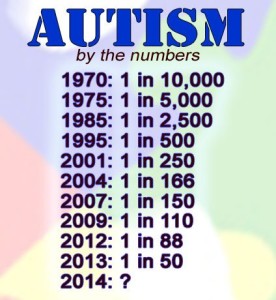Autism: Difference between revisions
No edit summary |
No edit summary |
||
| Line 1: | Line 1: | ||
[[File:Autism-1-in-50.jpg|right|thumb| what has changed in society to cause this increase? Could it be [[Vaccines|Vaccinations]]?]]The number of children diagnosed with autism or related disorders has grown at what many call an alarming rate. In the 1970s and 1980s, about one out of every 2,000 children had autism. Today, the CDC estimates that one in 150 8-year-olds in the U.S. has an autism spectrum disorder, or ASD. | [[File:Autism-1-in-50.jpg|right|thumb| what has changed in society to cause this increase? Could it be [[Vaccines|Vaccinations]]?]]The number of children diagnosed with autism or related disorders has grown at what many call an alarming rate. In the 1970s and 1980s, about one out of every 2,000 children had autism. Today, the CDC estimates that one in 150 8-year-olds in the U.S. has an autism spectrum disorder, or ASD. | ||
Autism is a neurodevelopmental ''disorder'' characterized by impaired social interaction, verbal and non-verbal communication, and restricted and repetitive behavior. Parents usually notice signs in the first two years of their child's life. These signs often develop gradually, though some children with autism reach their developmental milestones at a normal pace and then seem to regress. | |||
The actual cause and elements of Autism are being overthrown by Autisic people who have learned to communicate and are telling us what the problem really is. | |||
The diagnostic criteria require that symptoms become apparent in early childhood, typically before age three. It has long been presumed that there is a common cause at the genetic, cognitive, and neural levels for autism's characteristic triad of symptoms. However, there is increasing suspicion that autism is instead a complex disorder whose core aspects have distinct causes that often co-occur. The increase in Autism rates clearly demonstrates that genetics cannot be the source of the problem and doctors were wrong. | |||
{{#ev:youtube|vNZVV4Ciccg|300|right|This amazing girl proves autism is not what most doctors and everyone else think it is. [https://www.facebook.com/carlysvoice/ Carly's Voice] Time 9:52}} | {{#ev:youtube|vNZVV4Ciccg|300|right|This amazing girl proves autism is not what most doctors and everyone else think it is. [https://www.facebook.com/carlysvoice/ Carly's Voice] Time 9:52}} | ||
Revision as of 10:16, 24 March 2016

The number of children diagnosed with autism or related disorders has grown at what many call an alarming rate. In the 1970s and 1980s, about one out of every 2,000 children had autism. Today, the CDC estimates that one in 150 8-year-olds in the U.S. has an autism spectrum disorder, or ASD.
Autism is a neurodevelopmental disorder characterized by impaired social interaction, verbal and non-verbal communication, and restricted and repetitive behavior. Parents usually notice signs in the first two years of their child's life. These signs often develop gradually, though some children with autism reach their developmental milestones at a normal pace and then seem to regress.
The actual cause and elements of Autism are being overthrown by Autisic people who have learned to communicate and are telling us what the problem really is.
The diagnostic criteria require that symptoms become apparent in early childhood, typically before age three. It has long been presumed that there is a common cause at the genetic, cognitive, and neural levels for autism's characteristic triad of symptoms. However, there is increasing suspicion that autism is instead a complex disorder whose core aspects have distinct causes that often co-occur. The increase in Autism rates clearly demonstrates that genetics cannot be the source of the problem and doctors were wrong.
Mary Temple Grandin is an American professor of animal science at Colorado State University, world-renowned autism spokesperson and consultant to the livestock industry on animal behavior. She was diagnosed with autism and is someone who "thinks in pictures". Grandin sees the value in every individual's ability to make a contribution.
She talks about different kinds of minds and ways of thinking working together to produce real accomplishments. She worries about modern education creating a one size fits all like Common Core. She is concerned that our country is eating its educational seed corn with these narrow minding approaches to education and mental development.
The Amish and Mennonites have no autism in their communities. They do not vaccinate.
Here is a small sampling of the information available to connect mercury (in vaccines) to autism.
Robert Kennedy on the Vaccine Autism Coverup [1]
Part 1/2 Robert F. Kennedy JR tells the truth-Vaccine-Gov Cover up [2]
RECENT FED CT DECISION IN AUTISM CASE PROVES DR. CARLEY RIGHT [3]
Dr. Rebecca Carley's website: [4]
The following Audios can be found at Radio Liberty with Dr. Stan Monteith. [5]
Date: 12-02-09 Hour: 3 8:00: Dr. Russell Blaylock - Brain Inflammation (prerecorded) [6]
Date: 11-16-09 3:00: Bill Sardi - Vaccinating Pregnant Women For H1N1 [7]
Date: 10-16-09 Hour: b - 1 hr. 4:00: Dr. Russell Blaylock - Brain Health [8]